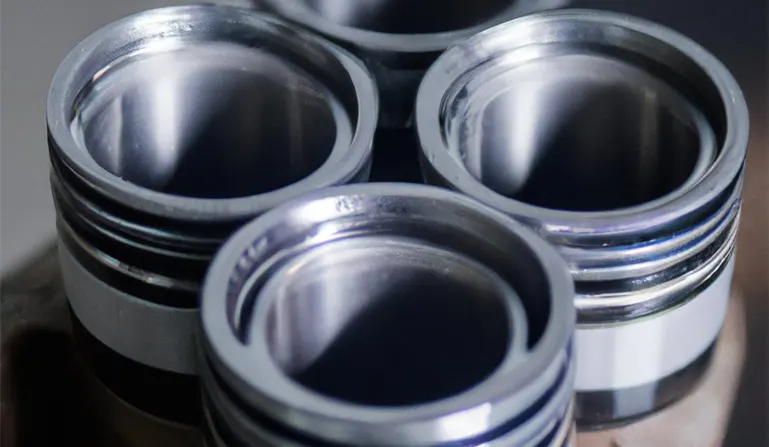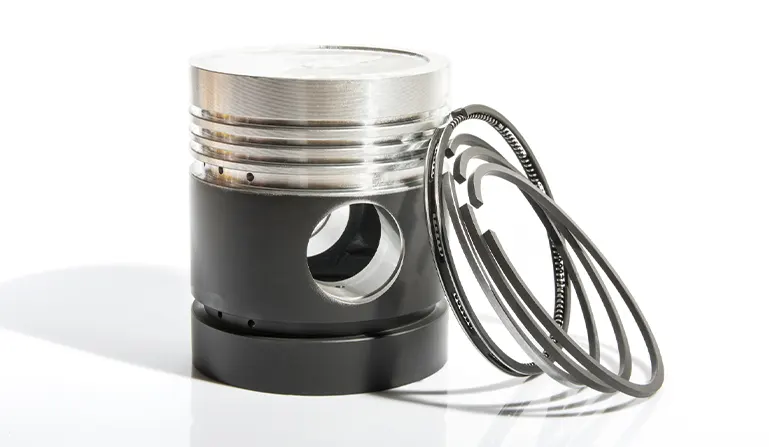Whether you are a seasoned mechanic or simply looking to maintain the health of your engine, a basic understanding of engine pistons and rings and their role in your vehicle is crucial.
You can keep your engine running smoothly for years with good knowledge and a commitment to proper maintenance and care.
What are pistons and rings?
Pistons and rings are fundamental components within an internal combustion engine that play pivotal roles in facilitating the engine’s operation and performance. The piston is a cylindrical component that moves up and down within the engine’s cylinder, converting the energy from the combustion of the air-fuel mixture into mechanical movement. It has a robust design to withstand high-pressure conditions and is connected to the crankshaft via a connecting rod, translating its linear movement into rotational motion that drives the vehicle.
On the other hand, piston rings are thin, circular bands situated in grooves on the outer diameter of the piston. They serve several crucial purposes:
- Compression Ring: The top ring(s), known as the compression ring, seals the combustion chamber, preventing the escape of combustion gases and ensuring maximum compression.
- Wiper Ring: If present, this ring assists the compression ring by further sealing the combustion chamber and aiding in oil control.
- Oil Control Ring: The bottom ring, or the oil control ring, regulates the oil on the cylinder walls, providing lubrication and preventing excessive oil from entering the combustion chamber.
Together, pistons and rings are indispensable in ensuring efficient combustion, maintaining optimal compression, controlling oil consumption, and facilitating the smooth, powerful operation of the engine. They work in harmony, with the piston executing the primary mechanical work and the rings ensuring sealing, lubrication, and heat dissipation within the engine’s cylinders.
The photograph below show the 3 separate pistons.

how pistons work?
Generally, a piston has a 4 stroke cycle in a combustion engine.
1st stroke – The intake phase
Air and fuel are taken in through the intake valves in the cylinders. During the intake phase, the pistons are pulled down, creating a vacuum in the valve.
2nd Stroke – Compression phase
The piston is forced back up the valve and the air and fuel mixture is compressed. At the end of the compression stroke, the spark plugs ignite them. At this time, all intake and exhaust valves need to be closed.
3rd Stroke – Power phase
During this phase, the explosive energy is converted to mechanical energy. At this time, the piston needs to be back down.
4th stroke – Exhaust phase
The burnt air and fuel are emitted through the cylinder. The piston is forced back upward. During this time, only the exhaust valves need to be opened and the intake valves should remain closed. The cycle starts all over again from the beginning.
What is the difference between cast and forged pistons?
| Piston Type | Manufacturing Process | Properties | Typical Applications |
| Cast Pistons | Molten metal poured into a mold | Less expensive, weaker, less durable | Most stock and everyday driving applications |
| Forged Pistons | Billet of metal forged under high pressure | Denser, stronger, lighter | High-performance and high-stress applications |
What is the purpose of the piston cleaning ring?
The piston cleaning ring, or oil control ring, is crucial for managing oil within the cylinder. It scrapes excess oil from the cylinder walls, preventing it from reaching the combustion chamber, which could lead to oil burning and smoke emission.
This action ensures adequate lubrication of the cylinder walls while maintaining optimal oil levels and minimizing contamination of the combustion process.

Symptoms of engine piston and ring problems
When engine pistons and rings are not functioning correctly, it affects engine performance and longevity. Some common symptoms of engine piston and ring problems include:
- Loss of compression: This can result in a decrease in engine power and acceleration, and a rough idle.
- Increased oil consumption: If the piston rings are worn or damaged, they may allow oil to leak into the combustion chamber, leading to increased oil consumption.
- Engine knocking: If the pistons are damaged or not moving smoothly, they can cause knocking sounds within the engine.
- Excessive engine vibration: Damaged or worn pistons can also cause excessive vibration. In return, other engine components can also wear out more quickly.
- Engine Misfires: If the compression in the engine is low, it can cause misfires, which can result in decreased engine performance and increased emissions.
- Engine oil pressure warning light: If the oil pressure in the engine is low, it can trigger a warning light on the dashboard.
Preventing engine piston and ring problems
By giving proper care to your engine piston and rings, it is easy to avoid common issues that come up over time.
- Regular Oil Changes: Applying fresh oil helps to keep the engine clean and prevents the build-up of carbon deposits that can cause problems.
- Avoid Overloading the Engine: Overloading the engine, such as towing heavy loads or driving in extreme conditions, can put additional stress on the pistons. So it is best to avoid such situations.
- Proper Engine Warm-Up: When you start the engine, the engine oil circulates and lubricates the engine components. So make sure to allow the engine to warm up properly before driving.
- Avoid Excessive Idling: Excessive idling can cause the engine to overheat and put additional stress on the pistons and rings.
- Drive Sensibly: Avoiding aggressive driving and rapid acceleration can help to reduce the stress on the engine and prevent problems with the pistons and rings.
- Regular Engine Maintenance: Regular engine maintenance, such as regular oil changes and checking the engine components is a good practice to extend the life span of the engine.
How do you clean pistons and rings?
Cleaning pistons and rings is a meticulous process that involves several steps to ensure they are free of carbon deposits and other residues, contributing to optimal engine performance. Here’s a more detailed, stepwise approach:
- Step 1: Remove Pistons and Rings
- Carefully disassemble the engine to access the pistons and rings.
- Ensure to keep track of the order and orientation of the parts for accurate reassembly.
- Step 2: Soak and Clean
- Submerge the pistons and rings in a suitable cleaning solution, such as a dedicated piston cleaner or a mixture of diesel and gasoline, for a specified duration.
- Utilize a piston ring expander tool to remove the rings from the pistons to clean them separately and access the piston grooves.
- For stuck rings, a product like Sea Foam can be used to help free them without disassembly.
- Step 3: Scrubbing
- Gently scrub the pistons and rings using a non-abrasive brush or pad to remove carbon deposits, paying extra attention to the ring grooves and lands on the piston.
- For stubborn deposits, consider using a piston ring groove cleaner tool, ensuring not to damage the surfaces.
- Step 4: Inspection
- After cleaning, inspect the pistons and rings for any signs of wear, cracks, or damage.
- Pay attention to the ring lands, ensuring they are free of any scoring or wear that could affect ring seating.
- Step 5: Rinsing and Drying
- Thoroughly rinse the pistons and rings with clean solvent or water to remove any remaining cleaning solution and debris.
- Ensure the parts are completely dry to prevent any rust or corrosion.
- Step 6: Reinstallation
- Carefully reinstall the piston rings onto the pistons using the ring expander tool, ensuring they are positioned correctly in their respective grooves.
- Reassemble the engine, ensuring all components are accurately placed and torqued to the specified settings.
- Step 7: Lubrication
- Before starting the engine, ensure to lubricate the pistons and cylinder walls adequately to prevent any dry start wear.
- Step 8: Test
- Start the engine and observe its operation, ensuring there are no unusual noises or issues, indicating successful cleaning and reinstallation.
This detailed stepwise approach ensures thorough cleaning and care of the pistons and rings, contributing to maintained engine health and performance. Always refer to the specific guidelines and practices related to your vehicle model and consult a professional mechanic when in doubt.
How often should piston & rings be changed?
The replacement of piston rings is generally advised between 60,000 to 200,000 miles, depending on the vehicle’s usage, maintenance, and engine health. However, signs of wear, such as reduced power, increased oil consumption, and excessive exhaust smoke, may necessitate sooner replacement. Adhering to regular engine check-ups and maintenance schedules will enhance the longevity and consistent performance of piston rings.
Can engine pistons and rings be repaired?
Can engine pistons and rings be repaired, or do they need to be replaced? In most cases, engine pistons and rings will need to be replaced when they become worn or damaged.
You can do some minor repairs such as honing the cylinder or replacing the oil control ring, replacing the entire piston and ring assembly is the best solution.
Worn or damaged pistons and rings can cause a number of issues, including loss of compression, increased oil consumption, engine knocking, and decreased performance. Repairing these components can help to address these problems, but it is often more effective to replace them entirely.
Conclusion
In this comprehensive guide, You have taken through a detailed exploration of pistons and rings within an engine, elucidating their pivotal roles and maintenance practices. The article meticulously unpacks the functionality, types, and purpose of pistons and rings, alongside providing a step-by-step guide on cleaning them and addressing common symptoms and preventive measures for issues related to these engine components. The guide not only enhances the reader’s understanding of these crucial engine parts but also empowers them with knowledge to undertake informed maintenance practices, ensuring optimal engine performance and longevity.
For more insightful and detailed guides on various car components and maintenance tips, explore further through the CarFinite blog.

John Smith, a Los Angeles-based car specialist and automotive writer, boasts over 20 years in the industry. With a background as a master technician and a decade-long writing stint at notable automotive publications, John now shares his expansive knowledge on CarFinite, simplifying car maintenance for readers.

